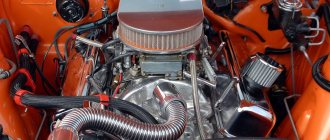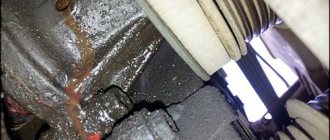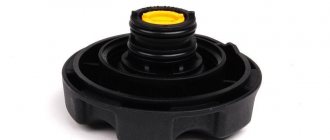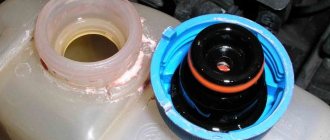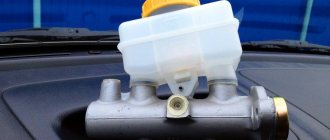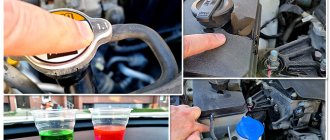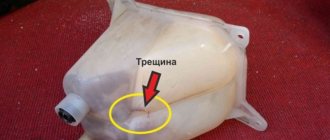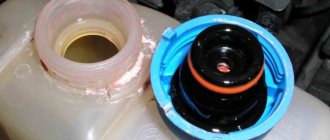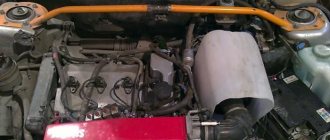When such an unpleasant situation as a coolant leak occurs, many owners of VAZ-2114 cars complain about this nuisance due to the great age of the car. However, of course, every car owner, when purchasing a car, inspected it and checked all components and parts for breakdowns, and would hardly have purchased such a car with leaks in the engine cooling system.
The video describes the process of finding the cause of an antifreeze leak on a VAZ car:
Scheme of the functioning of the cooling system.
Cars of the Samara-2 family (VAZ 2113, 2114, 2115) are equipped with a closed-type cooling system with forced circulation of coolant. The system maintains excess antifreeze pressure, which creates an increased boiling point and allows the liquid to heat up to 110-115°C.
1 – expansion tank plug; 2 – extended
Antifreeze, located in the cooling jacket of the cylinder head and block, removes the heat generated during fuel combustion in the engine. Fluid circulation is ensured by a centrifugal-type water pump (pump), which is driven by a timing belt. The cooling mode is set by a thermostat: at temperatures below 85°C, antifreeze flows in a small circle, providing quick warm-up of the engine, and when the value reaches 85 degrees, the thermostat opens a large circle, and hot antifreeze enters the radiator. When the car moves, the antifreeze in the radiator is cooled by blowing with a flow of oncoming air and then returns through the pipes to the engine block.
The antifreeze temperature is monitored by a sensor in the thermostat housing, information from which goes to the instrument panel indicator and to the car's ECU. When the antifreeze heats up to a certain temperature (95°, 98°, 105° - depending on the settings of the control unit), the electric motor of the fan located on the inside of the radiator automatically turns on. Also, on front-wheel drive VAZs, antifreeze from the engine transfers heat to the heater radiator to heat the interior.
An expansion tank with an antifreeze level sensor is used to fill the system with liquid. The total capacity of the VAZ 2114 system depends on the modification and averages 7.8 liters.
What are the dangers of squeezing antifreeze out of the expansion tank?
The consequences of knocking antifreeze out of the system can be very different: it all depends on at what stage the problem was discovered. If the antifreeze has already dropped below the minimum mark, then the cooling system will not be able to protect the engine from overheating.
The reason for this is the fact that burning fuel releases a huge amount of heat, which starts the vehicle engine. But only a small part of the engine requires heating. And if the motor housing is also exposed to high temperatures, then the entire engine may begin to work incorrectly. In addition, in modern cars the structures are made in such a way that the gaps and parts are located very closely to each other. For this reason, engine overheating will also lead to breakdowns of overhead cams, aluminum parts, and so on.
As mentioned above, antifreeze can be thrown out not only outside, but also inside, getting into the engine. This causes the engine oil to mix with antifreeze and lose its properties. This way the crankshaft can be locked.
In any case, it is recommended to carry out regular inspections of the vehicle in order to detect coolant leaks. The sooner the leak is detected, the less consequences the breakdown will have.
Signs of a malfunction of the cooling system.
Most often, failure of the cooling system is associated with loss of tightness, which leads to coolant leakage. The symptoms of this problem are easy to spot:
- reducing the level of antifreeze in the expansion tank below the minimum,
- a sharp increase in the temperature indicator readings on the instrument panel,
- copious steam of boiling liquid from under the hood,
- antifreeze drips on the engine protection or under the front of the car when parked.
Causes of antifreeze leaks.
A coolant leak occurs when one or more components of the cooling system fail:
Cylinder block.
The liquid coolant circulates in the engine block through a system of special channels - the cooling jacket. If a malfunction occurs, antifreeze may leak for the following reasons:
- insufficient tightening of the cylinder head bolts,
- head gasket failure,
- formation of metal microcracks.
If, after a long period of parking on a cold engine, coolant leaks are noticeable at the junction of the head and block, then most likely the cylinder head bolts are not tightened properly.
To eliminate a leak, check the tightness of the bolts and, if necessary, tighten them to the required torque. If the cylinder head gasket is damaged, the antifreeze goes inside the engine: either into the combustion chamber or into the crankcase.
Coolant entering the combustion chamber causes unstable engine operation (up to the impossibility of starting) and thick milky-white smoke from the muffler. Antifreeze that gets into the combustion chamber washes away all the carbon deposits until they shine, which can be determined by turning out the spark plugs and shining a flashlight into the spark plug wells. It is also possible that exhaust gases under pressure enter the cooling jacket and form vapor locks in it. In this case, in a well-warmed-up car at high speeds, there is a sharp increase in the amount of antifreeze in the expansion tank, until the expansion cap is knocked out.
If the coolant goes into the engine crankcase, it mixes with the oil. This fact can be diagnosed by the presence of a white emulsion coating on the oil filler cap and on the oil dipstick. A sharp darkening of fresh antifreeze is another symptom that the cooling system is in contact with oil. It is necessary to replace a broken or burnt cylinder head gasket.
The worst option is the appearance of microcracks: the symptoms are similar to the previous case, but it is problematic to eliminate this problem with your own hands. First of all, the crack may not be visible on the removed part, but it will certainly manifest itself when the bolts are tightened and on a warm engine. To eliminate microcracks, the head or block is polished using specialized equipment. In the worst case scenario, you will need to purchase a new cylinder head.
Difficulties in diagnosis
Despite the fact that all such reasons are obvious, it is not always possible to independently determine where the antifreeze goes from the expansion tank. For example, very often damage to pipes remains invisible to the naked eye. In such cases, experienced car enthusiasts advise letting the engine cool completely, dry your hands thoroughly and carefully feel each connecting element. Microcracks will definitely make themselves felt , and coolant leaks will form on the hose.
The situation is more complicated with defects in clamps. The tricky part is that the liquid will accumulate in large drops at the joints, then fall on the heated surface and instantly evaporate. The characteristic smell of antifreeze will help you notice the presence of a problem. It can be felt when the hood is open or in the cabin. If the leak occurs due to a loose connection in a hard-to-reach place, then, most likely, you will have to carefully study the condition of the system in the pit.
Another nuance is related to the protective elements under the bottom of the car. For example, the cause of a leak may be a malfunction with the gaskets installed in the pump. But the drops will fall on the protective casing, and antifreeze stains will form in the area under the radiator. In this case, you can search for a long time for the true cause of the breakdown.
The best advice in this case is to remove the protective casing and carefully examine the condition of all the main components of the cooling system.
Connecting pipes and clamps.
To connect all elements of the cooling system, rubber or silicone pipes are used, which are secured with metal clamps. Insufficient tightening of clamps, cracking and wear of pipes lead to antifreeze leaks. Some tips on how to avoid this:
- When performing routine vehicle maintenance, inspect the cooling system pipes for leaks, cracks and swelling;
- use hoses from trusted manufacturers (of rubber hoses, Balakovo hoses (BRT) are known, opinions vary on silicone hoses, but the main thing is not to take China);
- It is recommended to use clamps from NORMA. They provide reliable fixation, do not cut the hoses with their edges, and can also be tightened not only with a screwdriver, but also with a wrench, which is convenient for final crimping. Also, some car owners successfully use self-tightening (spring) clamps from foreign cars, selecting a set according to the diameters of the pipes.
- measure the force so as not to break off the fitting of the expansion tank or radiator, especially thin ones - steam exhaust ones;
- After replacing the pipes, you need to warm up the car, and then carefully tighten the clamps again to ensure a tight seal.
The cooling system of domestic cars requires constant monitoring and regular maintenance. If a minor malfunction of the cooling system is not corrected in time, it can ultimately lead to expensive engine repairs, so do not be lazy to periodically look under the hood.
Source
Choosing a faucet
Today, you can purchase three types of heater locking devices in auto stores:
- standard (regular standard faucet from VAZ) with a metal locking mechanism and a rubber membrane;
- ball (with a locking mechanism in the form of a movable ball with a hole);
- ceramic (has a locking mechanism of 2 ceramic plates).
None of the auto mechanics will recommend you install a standard crane. It will not last long, and the price is not much different from the modernized models. Replacing the VAZ-2114 heater valve with a ball valve will allow it to work a little longer, but will not completely solve the problem, since its locking mechanism is also metal.
Ceramic devices have proven themselves best. They have a plastic case and a ceramic mechanism that is not susceptible to oxidation processes. Such a device will work for a long time if the seals do not fail.
Below is a table of heater valve models for VAZ-2114 vehicles, indicating the manufacturer, catalog number and type of locking mechanism.
Locking mechanism material
Simplified operation of the VAZ 2114 cooling system
The coolant enters the water jacket of the engine block through the pipes. In the water jacket, the coolant circulates in a small circle until the engine (and therefore the coolant) reaches a temperature of 95 degrees Celsius.
At this moment, the thermostat opens and coolant is delivered through the pipes to the radiator. The radiator removes excess heat from the coolant. Excess hot coolant returns to the expansion tank.
The entire cooling system is under high pressure of 1.2-1.8 atmospheres, due to the operation of the pump and the increase in coolant volume due to heating.
From the above text we conclude: malfunctions of the cooling system are not easy to detect with small leaks, since the coolant evaporates almost immediately, having a high temperature, and work to find the location of the leak sometimes requires the intervention of a professional.
Step 1. The pipe burst
Since the pipes are the “blood vessels” of the car, failure of any of them will result in loss of coolant.
This malfunction is clearly visible on a warm engine while driving. A large amount of steam appears from under the hood. The burst pipe is clearly visible.
But there are times when the coolant leak is small. Then, first of all, attention should be paid to the articulation of the pipes with the vehicle components.
When using coolant in the form of antifreeze or antifreeze, a characteristic oily coating remains in the leak areas.
conclusions
However, in any case, even if the cooling system tank is partially malfunctioning, it is better not to waste a couple of hundred and buy a new tank, having previously chosen a known quality one. Good roads to everyone and stable temperatures!
I decided to write a separate entry about this since many people have such symptoms, but I couldn’t find the reason for a very long time, since on the forums, incl. on Drive everyone wrote that my head was “broken”, “there is air in the system”, “bad cap”, etc. But in the end the reason turned out to be completely different! Description of the problem: I pour antifreeze to the level (just below the MAX mark) and start the engine. As long as the engine is cold everything is fine. That is, you can gas as much as you like and nothing spills out or happens (that’s why I dismissed the option of a broken head or gasket right away). But as soon as the temperature rises to 90-95 degrees (including at idle), the antifreeze level begins to rise sharply and, as a result, the tank overflows and the liquid flows out before the fan turns on. As soon as the fan turns on, after 2 seconds everything returns to normal, but everything has already poured out of the tank and it remains empty. I thought that the antifreeze was cheap and bad and boiled ahead of time (expanded and overflowed), I bought more expensive antifreeze, drained the old one, poured in a new one, but nothing changed.
I connected the laptop and saw that the antifreeze began to overflow the tank at a temperature of 93 degrees, that is, the indicators coincided with the instrument panel readings. And this is a temperature at which even water in the system would not boil! Since two temperature sensors showed that antifreeze was pouring out at a temperature of 93-95 degrees, at first I had no doubt about the correctness of their readings. BUT, when I removed the temperature sensor that goes to the ECU, I saw this:
Fix it yourself or go to a service station?
Once again I want to draw your attention, this is very important! All work on replacing cooling system elements is carried out exclusively with the engine turned off and the coolant cooled down.
You can replace the pipes, thermostat, radiator filler cap, and expansion tank cap yourself. Remove the filler cap on the radiator. Unscrew the drain plug on the engine and drain the coolant into a clean container.
As for replacing the gasket between the valve head and the piston block, repairing a rotten engine cooling jacket and repairing radiators, these works are best done at specialized stations.
Since such repairs will require the use of specific tools and the necessary experience and knowledge.
Crane dismantling
We go into the car interior to the front passenger seat. There is a panel cover to the left of the passenger's feet. It must be removed by unscrewing the screws with a Phillips screwdriver. Now that we have access to the heater radiator cap and tap, we place a dry rag under them. It is needed in case of coolant leakage.
Using a screwdriver with a cross-shaped bit, loosen the clamps of the pipes on the locking device and disconnect them.
Next, replacing the heater valve requires disconnecting the drive cable. We take pliers and, holding the rod bracket with them, use a flat screwdriver to disconnect the drive cable. After this, we move again to the engine compartment.
Using a 10mm wrench, unscrew the nuts securing the faucet. Next, remove the broken locking device on the front passenger side.
Several important nuances when choosing cooling system components
The most important thing is to use special antifreeze or antifreeze liquids, which have a higher boiling point.
Choose pipes from well-known manufacturers, do not skimp on this. Especially when making replacements inside the car.
Replace the expansion tank cap only with the original one. Do not reduce the number of coils of the spring, they are designed for a certain pressure. It is important!
When replacing the radiator and thermostat, pay special attention to the volume and response temperature. This is critical for proper engine operation. Excessive or too low temperatures will lead to either overheating of the engine, or it will not heat up to operating temperature at all.
Reasons for the appearance of antifreeze under the rug
What are the reasons for such a dangerous effect:
- The stove tap broke.
- Rupture of the material structure or surface of the heater radiator.
How to fix
Now that the causes have been identified, it is worth considering possible solutions to the problem. Before we begin, it should be noted that these reasons can easily be eliminated independently and it is not necessary to contact a car service. Let's look at how to solve the problem of antifreeze on the interior carpet.
Stove faucet
In the process of replacing the stove valve
In this case, the leakage of antifreeze may be caused by the fact that the heater faucet has worn out. Mostly, the leak will form under the driver's mat and occurs only in a certain operating mode of the heater. This malfunction can be treated simply by replacing the heater tap.
Heater radiator
Faulty heater radiator
The second most common reason is a leak from the heater core. Here you need to be careful and quickly fix the problem, since antifreeze gets not only onto the interior mats, but also affects its location.
So, if coolant leaks out, there is a possibility of damaging other components, especially the main one - the electronic control unit.
